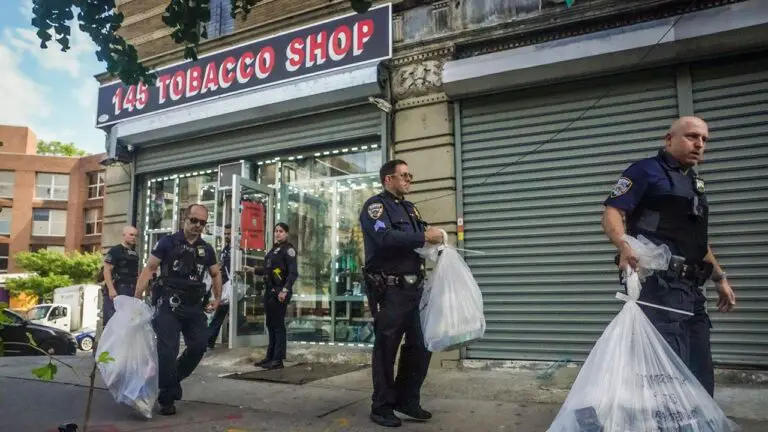Communities Grapple with Disposing of Disposable E-Cigarettes
The rising popularity of disposable e-cigarettes has ushered in a new challenge for communities in the United States: safely disposing of millions of small, battery-powered devices classified as hazardous waste.
For years, discussions about vaping predominantly focused on the risks it posed to high school and middle school students attracted by enticing flavors such as gummy bear, lemonade, and watermelon.
However, the recent shift towards non-refillable e-cigarettes has created a fresh environmental predicament. These devices, containing nicotine, lithium, and other metals, cannot be reused or recycled. They are also not supposed to be discarded in the trash, as per federal environmental laws.
In the U.S., approximately 12 million disposable vapes are purchased monthly by teens and adults. With limited federal guidance, local authorities are devising their methods to manage e-cigarettes collected from schools, colleges, vape shops, and other locations.
The Dilemma at Hand
“We find ourselves in an unusual regulatory situation where there is no legal disposal option, yet we know that tens of millions of disposables end up in the trash every year,” said Yogi Hale Hendlin, a health and environmental researcher at the University of California, San Francisco.
In late August, sanitation workers in Monroe County, New York, packed more than 5,500 brightly colored e-cigarettes into 55-gallon steel drums for transportation. Their destination? A large industrial waste incinerator in northern Arkansas, where they would be melted down.
Sending 350 pounds of vapes across the country for incineration may not sound environmentally friendly. Still, local officials assert it’s the only way to prevent these nicotine-filled devices from entering sewers, waterways, and landfills, where their lithium batteries can pose a fire hazard.
A Costly and Complicated Challenge
Disposing of these e-cigarettes has become both costly and complex. For example, in New York City, officials are confiscating hundreds of thousands of banned vapes from local stores, with each one costing about 85 cents to dispose of.
Critics of vaping argue that the industry has evaded responsibility for the environmental consequences of its products, while federal regulators have not compelled changes that could make vaping components easier to recycle or less wasteful.
One potential solution is setting standards that mandate e-cigarettes to be reusable or requiring manufacturers to fund collection and recycling programs. However, such requirements don’t currently apply to vaping products under federal law.
Environmental Impact
The Environmental Protection Agency’s rules for hazardous waste do not apply to households, meaning it is legal for individuals to throw e-cigarettes in the trash at home. Nevertheless, most businesses, schools, and government facilities must adhere to EPA standards when handling harmful chemicals like nicotine.
In the U.S., efforts to manage disposable e-cigarettes have mainly stemmed from schools, which may face stricter regulations if they generate over a few pounds of hazardous waste per month. Monroe County schools pay $60 for the disposal of each one-gallon container of vapes, and more than two-thirds of the e-cigarettes collected by the county come from schools.
A Study in Unintended Consequences
The surge in disposable e-cigarettes is a case of unintended consequences. In early 2020, the Food and Drug Administration banned nearly all flavors from reusable e-cigarettes, such as Juul. However, this policy did not extend to disposables, leading to the proliferation of numerous new fruit and candy-flavored vapes, primarily manufactured in China.
Recently, the FDA has sought to block imports of various leading disposable brands, including Elf Bar and Esco Bar, considering them illegal. Still, they continue to enter the U.S. and are now prevalent in convenience stores, gas stations, and other retail outlets.
FDA’s tobacco chief, Brian King, noted that his agency is carefully considering the potential environmental impacts of vaping products.
The Cost of Confiscating Disposable E-Cigarettes
In 2020, New York City prohibited the majority of e-cigarette types, banning flavors that could appeal to youngsters. City employees conduct thousands of inspections annually, issuing citations to stores selling illegal flavored products.
Since last November, officials have seized more than 449,000 vape units. New York City spends around $1,400 to destroy each container of confiscated vapes.
For now, New Yorkers who vape can bring their used e-cigarettes to city-sponsored waste-collection events. Ultimately, these vapes are shipped to Arkansas for incineration.
Recycling Efforts
Boulder County, Colorado, is one of the few U.S. jurisdictions actively attempting to recycle e-cigarette batteries and components. Historically, Boulder had one of the highest teen vaping rates in the country.
Beginning in 2019, county officials distributed bins to schools for confiscated or discarded e-cigarettes. Last year, they collected 3,500.
County staff sort the devices, separating those with removable batteries for recycling. Disposables are packed and shipped to be incinerated. Managing vape waste has become more costly and labor-intensive with the shift to disposables.
“I kind of miss the days when we had Juuls and I could take each battery out and recycle them very easily,” said Shelly Fuller, who directs the program. “No one has time to dismantle a thousand Esco Bars.”

